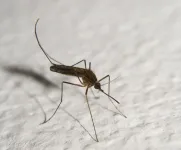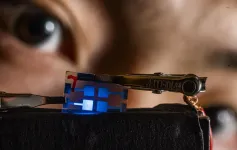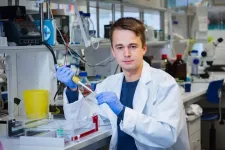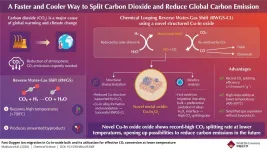Bacteria carried by mosquitos may protect them against pesticides
Common bacteria naturally transmitted between insects found to make them less susceptible to insecticides used to control their numbers
2021-01-13
(Press-News.org) A common bacterial species naturally infecting mosquitoes may actually be protecting them against specific mosquito pesticides, a study has found.
Wolbachia - a bacterium that occurs naturally and spreads between insects - has become more frequently used in recent years as a means of controlling mosquito populations.
Scientists at the University of Reading, and the INBIOTEC-CONICET and the National University of San Juan in Argentina, studied the effect of Wolbachia on a common mosquito species and found those carrying the bacteria were less susceptible to widely used pesticides.
Dr Alejandra Perotti, an Associate Professor in invertebrate biology at the University of Reading, and a co-author of the study, said: "This shows the importance of looking more closely at how bacteria in mosquitoes and pesticides interact, especially at a time when new plans are being formulated for which methods to use, where to use them and which species to target."
Mosquitoes transmit several diseases like dengue fever, malaria, zika and yellow fever to humans through their bites, and collectively kill more than a million people worldwide every year.
In the new study, published in Scientific Reports, the researchers looked at Culex quinquefasciatus - also known as the southern house mosquito - that had been reared for several years under environmental controlled conditions at a lab in Argentina (INBIOTECT insectary).
This is one of the most widespread species in countries with hotter climates. The mosquito species transmits several diseases, a wide range of viruses such as the West Nile Virus (WNV), the San Luis Encephalitis Virus (SLEV) and the Venezuelan Equine Encephalitis Virus, and in addition a variety of parasites (filarial worms) in Central and South America, Africa and Asia.
The team found that the mosquito larvae naturally infected by an Argentinian native strain of Wolbachia were less susceptible to three bacterial pesticides (Bacillus thuringiensis israelensis, Bacillus wiedmannii biovar thuringiensis, and Lysinibacillus sphaericus), two of which are commercially available and used in many countries to control mosquito populations.
INFORMATION:
[Attachments] See images for this press release:

ELSE PRESS RELEASES FROM THIS DATE:
2021-01-13
Without immediate and drastic intervention, humans face a "ghastly future" -- including declining health, climate devastation, tens of millions of environmental migrants and more pandemics -- in the next several decades, according to an international team of 17 prominent scientists. ...
2021-01-13
Researchers at Linköping University, Sweden, have developed efficient blue light-emitting diodes based on halide perovskites. "We are very excited about this breakthrough", says Feng Gao, professor at Linköping University. The new LEDs may open the way to cheap and energy-efficient illumination.
Illumination is responsible for approximately 20% of global electricity consumption, a figure that could be reduced to 5% if all light sources consisted of light-emitting diodes (LEDs). The blue-white LEDs currently in use, however, need complicated manufacturing methods and are expensive, which makes it more difficult to achieve ...
2021-01-13
Atomic nuclei are held together by the strong interaction between neutrons and protons. About ten percent of all known nuclei are stable. Starting from these stable isotopes, nuclei become increasingly unstable as neutrons are added or removed, until neutrons can no longer bind to the nucleus and "drip" out. This limit of existence, the so-called neutron "dripline", has so far been discovered experimentally only for light elements up to neon. Understanding the neutron dripline and the structure of neutron-rich nuclei also plays a key role in the research program for the future accelerator facility FAIR at the GSI Helmholtz Centre for Heavy Ion Research in Darmstadt.
In a new study, "Ab Initio Limits of Nuclei," ...
2021-01-13
The levels of small molecules called microRNAs (miRNAs) circulating in blood could help identify early on children with life-threatening forms of malaria, according to a study led by the Barcelona Institute for Global Health, an institution supported by "la Caixa" Foundation, in collaboration with the Manhiça Health Research Center (CISM) in Mozambique. The results, published in Emerging Infectious Diseases journal, could also help better understand the mechanisms underlying severe malaria.
Malaria mortality among young African children remains unacceptably high. To improve the outcome, it is important to rapidly identify and treat children with severe forms of the disease. ...
2021-01-13
Overview:
Associate professor Masaya Tamura, Kousuke Murai (who has completed the first term of his master's program), and their research team from the Department of Electrical and Electronic Information Engineering at Toyohashi University of Technology have successfully transferred power and data wirelessly through seawater by using a power transmitter/receiver with four layers of ultra-thin, flat electrodes. In the field of wireless power transfers, seawater behaves as a dielectric with extremely high loss, and achievement through capacitive coupling is difficult. Up until now, it had been thought that wireless power transfers could only be achieved through magnetic coupling. ...
2021-01-13
Researchers from the University of Seville and the University of Pavia have identified a link between Amyotrophic Lateral Sclerosis (ALS) and the accumulation of DNA-RNA hybrids in the genome. The accumulation of these hybrids causes increased genomic damage and boosts genetic instability. This finding will make it possible to better understand the molecular basis of the disease, as well as to propose new solutions to curb it.
Amyotrophic Lateral Sclerosis (ALS) is a neurodegenerative disease of the central nervous system, characterised by progressive degeneration ...
2021-01-13
The descendants of regular wild-type bacteria can evolve to survive for a long time on metallic copper surfaces that would usually kill them within a few minutes. An international research team led by Martin Luther University Halle-Wittenberg (MLU) and the Bundeswehr Institute of Microbiology was able to produce these tiny survivalists in the lab and has been able to study them more closely. The team reports on its findings in Applied and Environmental Microbiology.
Bacterial infections are usually treated with antibiotics. However, in recent decades many pathogenic bacteria have developed an increasing tolerance to common drugs. So-called multidrug-resistant bacteria are of particular concern as ...
2021-01-13
It is politically agreed and necessary for climate protection reasons that our entire economy becomes climate-neutral in the coming decades - and that applies to air travel, too. This is a technically feasible goal, and there are numerous ways to achieve it. ETH Professor Marco Mazzotti and his team have now compared the options that appear to be the easiest to implement in the short and medium term and evaluated them according to factors such as cost-effectiveness.
The ETH researchers conclude that the most favourable option is to continue powering aircraft with fossil fuels in future, but then remove the associated CO2 emissions from the atmosphere ...
2021-01-13
Fuchs' corneal dystrophy is one of the most common eye diseases diagnosed in almost 5% of the population of Europe aged 40 years or over. It is a hereditary eye disease that causes vision impairment and typically manifests in middle age. The first symptoms of the disease - blisters on the surface of your cornea - resemble cataract at first glance. The disease progresses from the centre of the cornea affecting all layers of the cornea. The progression of the disease varies from individual to individual and in severe cases results in vision loss.
The molecular neurobiology ...
2021-01-13
With ever-worsening climate change, there is a growing need for technologies that can capture and use up the atmospheric CO2 (carbon dioxide) and reduce our carbon footprint. Within the realm of renewable energy, CO2-based e-fuels have emerged as a promising technology that attempts to convert atmospheric CO2 into clean fuels. The process involves production of synthetic gas or syngas (a mixture of hydrogen and carbon monoxide (CO)). With the help of the reverse water-gas shift (RWGS) reaction, CO2 is broken down into the CO necessary for syngas. While promising in its conversion efficiency, the RWGS reaction requires incredibly high temperatures (>700°C) to proceed, while also generating ...
LAST 30 PRESS RELEASES:
[Press-News.org] Bacteria carried by mosquitos may protect them against pesticides
Common bacteria naturally transmitted between insects found to make them less susceptible to insecticides used to control their numbers




